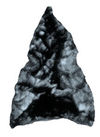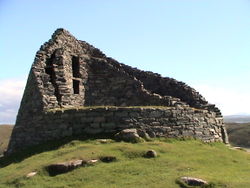Prehistoric man
2007 Schools Wikipedia Selection. Related subjects: Ancient History, Classical History and Mythology

Prehistory (Latin word præ = before and Greek word ἱστορία = history) is a term usually used to describe the period before written history became available. Paul Tournal originally coined the term Pré-historique in describing the finds he had made in the caves of southern France. The term has been used in French since the 1830s to describe the time before writing. It was introduced into English by Daniel Wilson in 1851.
The date marking the end of prehistory (the date when written historical records become a useful academic resource), varies from region to region. In Egypt it is generally accepted that prehistory ended around 3500 BC whereas in New Guinea the end of the prehistoric era is set much more recently, at AD 1900.
Age systems
Until the arrival of humans, a geologic time scale defines periods in prehistory. Archaeology has augmented this record and provided more precise divisions during human prehistory.
Human prehistory in the Old World is often subdivided by the three-age system. This system of classifying human prehistory creates three consecutive time periods named for their respective predominant tool-making technologies. In the New World other naming schemes have been defined, such as the scheme listed in the Archaeology of the Americas.
These very general systems of dividing up prehistory are being found to be increasingly inapplicable as archaeological discoveries suggest a much more complex view of prehistory.
Three-age system
- Stone Age
- Paleolithic Period
- Mesolithic Period
- Neolithic Period
- Bronze Age
- Iron Age
The three-age system is a system of classifying human prehistory into three consecutive time periods named for their respective predominant tool-making technologies.
The system is most apt in describing the progression of European society, although it has been used to describe other histories as well. The system has been criticised for being too technologically determinist.
Stone Age and its People
The Stone Age is a broad prehistoric time period during which humans widely used stone for toolmaking.
Stone tools were made from a variety of different kinds of stone. For example, flint and chert were shaped (or chipped) for use as cutting tools and weapons, while basalt and sandstone were used for ground stone tools, such as quern-stones. Wood, bone, shell, antler and other materials were widely used as well. During the most recent part of the period, sediments (like clay) were used to make pottery. A series of metal technology innovations characterize the later Copper Age, Bronze Age and Iron Age.
The period encompasses the first widespread use of technology in human evolution and the spread of humanity from the savannas of East Africa to the rest of the world. It ends with the development of agriculture, the domestication of certain animals and the smelting of copper ore to produce metal. It is termed prehistoric, since humanity had not yet started writing. Recorded history is the traditional start of history.
The term "Stone Age" was used by archaeologists to designate this vast pre-metallurgic period whose stone tools survived far more widely than tools made from other, softer materials. It is the first age in the three-age system and was subdivided into the Palaeolithic, Mesolithic and Neolithic periods by John Lubbock in his now classic 1865 book Pre-historic Times. These three periods are further subdivided. In reality, the succession of phases differs enormously from one region (and culture) to another. Indeed, humanity continued to expand into new areas even during the metal ages, so it is therefore better to speak of a Stone Age, instead of the Stone Age. The old stone age, or Palaeolithic period, began with Homo habilis. Some 1.75 million years ago, a new species appeared. This Homo erectus (upright man), who spread from Africa as far as Europe and Asia. Homo erectus had a bigger brain than Homo habilis, made better tools, and was probably the first human being to use fire. Some time after 400,000 years ago, yet another human being came on the scene.This was Homo sapiens (wise man). The neanderthals people (named after a valley in Germany), Lived in Europe and the middle East until about 35,000 years ago. The Neanderthals successfully survived cold period of the Pleistocene Ice Age by living in caves.
Prehistoric Culture
At least two types of Homo sapiens lived side by side - early homo sapiens (the Neanderthals) and a subspecies, Homo sapiens sapiens, who looked more like mordern human beign.The Neanderthals were much larger and lacked a chin. They used simple tools and had probably developed a language to speak to one another. For some reason, the Neanderthals died out, leaving our species as the only humans on Earth. The surviving people -- such as the Cro-Magnons -- lived all over Europe during the stone age period. These prehistoric peoples built simple wooden huts, fished and hunted deer and wild cattle, moving onin search of food. They began to express themselves through art, drawing pictures on cave walls and carving stones into human shapes. There are famous example of detailed cave paintings in Lascaux in France and Altamira in Spain.
Copper Age
The Chalcolithic (Greek khalkos + lithos 'copper stone') period, also known as the Eneolithic (Aeneolithic) or Copper Age period, is a phase in the development of human culture in which the use of early metal tools appeared alongside the use of stone tools.
The literature of European archaeology generally avoids the use of 'chalcolithic' (they prefer the term 'Copper Age'), while Middle-Eastern archaeologists regularly use it. The Copper Age appeared much earlier in the Middle East than in Europe. The transition from the European Copper-Age to its own full-fledged Bronze-Age, however, is far more rapid. The Europeans treated their prestige copper/bronze objects rather much like they did their stone objects, whereas the Middle East had progressed beyond this.
The period is a transitional one outside of the traditional three-age system, and occurs between the neolithic and bronze ages. It appears that copper was not widely exploited at first and that efforts in alloying it with tin and other metals began quite soon, making it more difficult to distinguish distinct Chalcolithic cultures and periods.
Because of this, the term is usually only applied by archaeologists in some parts of the world, mainly southeast Europe and Western and Central Asia where it appears around the 4th millennium BC. Less commonly, it is also applied to American civilizations which already used copper and copper alloys at the time of European conquest.
The European Beaker people are often considered Chalcolithic as were the cultures which first adopted urbanisation in south west Asia. Many megaliths in Europe were erected during this period and it has been suggested that Proto-Indo-European linguistic unity dates to around the same time.
Ötzi the Iceman, found in the Ötztaler Alps and whose remains have been dated to about 3300 BC, carried a copper axe and flint knife. He appears to have been in a region of Europe which was transitioning through this period at that time.
Bronze Age
The Bronze Age is a period in a civilization's development when the most advanced metalworking (at least in systematic and widespread use) consisted of techniques for smelting copper and tin from naturally occurring outcroppings of ore, and then alloying those metals in order to cast bronze.
The earliest evidence of bronze metalworking dates to the mid 4th millennium BC Maykop culture in the Caucasus. From there, the technology spread rapidly to the Near East and after some time to the Indus Valley Civilization (see Meluhha).
Iron Age
In archaeology, the Iron Age is the stage in the development of any people when the use of iron implements as tools and weapons is prominent. The adoption of this new material coincided with other changes in some past societies, often including differing agricultural practices, religious beliefs and artistic styles, although this was not always the case.
The Iron Age is the last principal period in the three-age system for classifying pre-historic societies, preceded by the Bronze Age. Its date and context varies depending on the country or geographical region. Classically, the Iron Age is taken to begin with the Greek Dark Ages in the 12th century BC in Greece and the Ancient Near East, the 11th century BC in India and between the 8th ( Central Europe) and 6th ( Northern Europe) centuries BC in Europe. The Iron Age is usually taken to end with the onset of historical tradition during Hellenism and the Roman Empire, or the Early Middle Ages in the case of Northern Europe.
The Iron Age roughly corresponds to the stage at which iron production was the most sophisticated form of metalworking. Iron's hardness, high melting point and the abundance of iron ore sources made iron more desirable and "cheaper" than bronze and contributed greatly to its adoption as the most commonly used metal. The arrival of iron use in various areas is listed below, broadly in chronological order. Because iron working was introduced directly to the Americas and Australasia by European colonization, there was never an iron age in either location.
The first signs of iron use come from Ancient Egypt and Sumer, where around 4000 BC small items, such as the tips of spears and ornaments, were being fashioned from iron recovered from meteorites (see Iron: History). Between 3000 BC to 2000 BC increasing numbers of smelted iron objects (distinguishable from meteoric iron by the lack of nickel in the product) appeared in Anatolia, Egypt, Mesopotamia and the Indus Valley (Pakistan and North India). However, their use appears to be ceremonial, and iron was an expensive metal, more expensive than gold. Some sources suggest that iron was being created then as a by-product of copper refining, as sponge iron, and was not reproducible by the metallurgy of the time.
The earliest systematic production and use of iron implements appears from the 14th century BC in the Hittite Empire though recent excavations in Middle Ganga Valley in India done by archaelogist Rakesh Tewari show iron-working in India since 1800 BC. By 1200 BC, iron was widely used in the Middle East but did not supplant the dominant use of bronze for some time.


